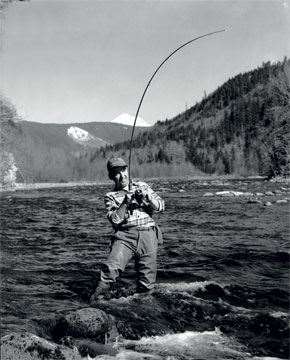Modern Anglers can thank watchmaker Jasper R. Dell Hull for those easy weekend castoffs
Modern Anglers can thank watchmaker Jasper R. Dell Hull for those easy weekend castoffs
 Getty Images
Getty ImagesIf any one man ever contributed to the popularisation of the world’s most, well, popular pastime, it was R.D. Hull, the man who invented the casting reel.
The history of fishing goes back a long way. Its very necessity has ensured it’s one activity common to cultures the world over. Mankind’s various attempts at improving it are as old as fishing itself.
Although many variations of the old bait-on-a-string and string-on-a-stick have been concocted over the centuries, there is evidence that the more sophisticated idea of the fishing reel, and its many variations, has been around just as long, as 2000-year-old Chinese artworks attest. Somehow, the idea always seemed logical, even in the absence of light materials and engineering capabilities. By the 20th Century, the world was ready to reel ‘em in – at least in theory.
By the year 1947, the reel had advanced to a stage where it was just too complicated. Most models used for natural baits and heavy lures had revolving spools, and very rarely did the revolving spool synchronise with the departing fishing line. Instead, the spool revolved faster. This created snarls, known in the game as “backlashes”, which made the whole thing a misery for the average fisherman. Casting without backlashing was an art-form far too esoteric for the neophyte angler.
Jasper R. Dell Hull, better known as R.D. Hull, was a Texas watchmaker. Precision was his game. In ‘47, while applying for a position working on the timing devices used for explosives at the Zero Hour Bomb Company in Tulsa, Oklahoma, he approached the bemused general manager, Harold Binford, and his legal counsel with his prototype of the backlash-free reel, called the Lashmaster. It was made from a metal lid procured from a tin of Folgers Mountain Grown Drip Grind Coffee (it seems everything was complicated in those days!), a foot-long piece of wire, a wooden sewing spool and some braided nylon line (a new-fangled material, nylon had been adopted by fishing after the invention of the monofilament line), all nailed to a board for ease of demonstration.
Hull’s idea occurred to him in a grocery store as he watched the clerk pull string from a spool to wrap a package. Of course, the spool was fixed; stationary. And, of course, with fewer moving parts, the string didn’t tangle. After he’d finished, the GM and the legal counsel looked at the contraption, looked at each other, considered the shrinking commercial landscape for explosives manufacturers and shrugged, “Why not?” It began what was to become a remarkable example of commercial alchemy.
They partnered with Hull and together they produced their first reel, called the Standard, in May 1949. They promptly manufactured 25 versions of Hull’s invention and named them close-faced reels. Within a short time the Zero Hour Bomb Company was making more money manufacturing reels than time bombs. However, their new invention would be, metaphorically, just that. It was about to revolutionise fishing forever.
There remained for them the marketing issues any bomb manufacturer might face if it tried to tell the world it was now in the business of fishing. President Dwight D. Eisenhower inadvertently fixed that. “Ike” was an avid angler and in 1956 the Zero Hour Bomb Company sent him a package, which proudly displayed the Zero Hour Bomb Company name and logo. He finally got his reel, but not before the package was intercepted by White House security, submerged in water and scrutinised by the bomb squad, who’d been called in to examine the suspicious box.
It was time for a name change ... Not only did the company immediately start calling itself Zebco, but it got out of the explosives game completely and began its journey as one of the world’s leading fishing tackle, rod and boating supply manufacturers.
Hull’s closed-face reel eventually became known as the spin-cast reel. It was durable, it was cheap, it came already spooled with line and though angling snobs ignored it initially, it broke down all those barriers for aspiring fishermen and brought tens of thousands of new participants to the sport.
Hull went on to design and patent 26 more reels and was inducted into the Sporting Goods Hall of Fame. He retired from Zebco in January 1977, having fulfilled a life-long ambition to make his childhood obsession of fishing easier and more enjoyable, and died in December of that year.
‒ Robert Drane
Related Articles

Feature Story: Moving the Needle

The Aussies at The Open













